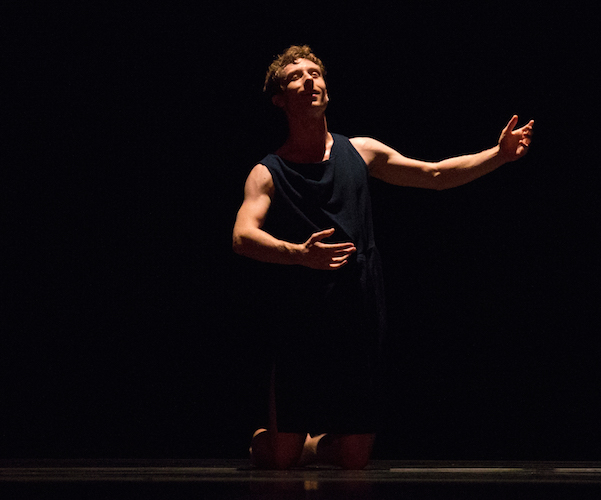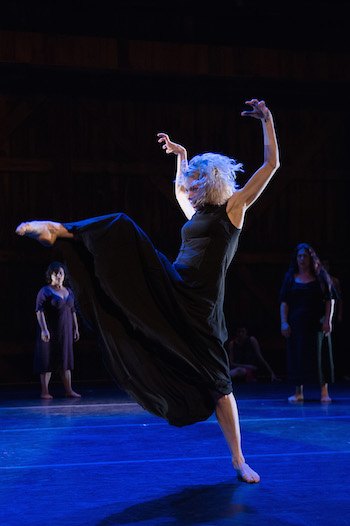Fuse Dance Review: Gauthier Dance — Distinctive Exuberance
As a group they are exuberant, personable, immediate, which in turn makes even the meh choreography palatable.
Gauthier Dance//Dance Company Theaterhaus Stuttgart at Jacob’s Pillow Dance Festival, Becket, MA, through July 10.

Luke Prunty of Gauthier Dance//Dance Company Theaterhaus Stuttgart in Johan Inger’s “Now and Now.” Photo: Hayim Heron.
By Janine Parker
What a strange conundrum we have in the current concert dance scene. In addition to long-established “big box” companies there are many small to midsize contemporary groups — and always more emerging from the woodwork. And of them, many — like Gauthier Dance//Dance Company Theaterhaus Stuttgart, appearing this week at Jacob’s Pillow — are packed with excellent, well-trained, highly-versatile dancers. The works they perform are occasionally excellent, often at least decent. (Rarely are they simply bad, though sometimes they’re simply meh.) There is no shortage of good dancing. So what’s the problem?
It’s a bit of a catch-22. The dancers are versatile because they must perform the wide range of movement styles found in most repertoires today, with companies sharing works by many of the same choreographers. Yet this makes distinctive artistic efforts harder to come by. Happily, the individuals in artistic director Eric Gauthier’s nine year-old company are just that — individuals, with distinguishable physicalities. As a group they are exuberant, personable, immediate, which in turn makes even the meh choreography palatable.
In this, Gauthier Dance’s second visit since its Pillow début last year, there was some drag to the opening night performance. I chalk it up to the overlong program (and, yeah, a bit of meh choreography). While last year’s show offered more dances (seven, good lord!), there was just the right balance and flow to that evening. Also, earlier this year the company announced the premiere of an evening-length dance titled “Nijinski.” I hoped we’d have the chance to see the group dig deeply into this long piece. Well, perhaps another time. This week’s program includes four short dances in the first part and a 30-minute dance in the second. Because of last year’s critical and popular success (I was among the instant devotees), the company has been moved from the Doris Duke Theatre into the larger Ted Shawn. It might sound like a cliché, but that doesn’t mean it isn’t true: There’s something about the proscenium-less intimacy of the Duke that works well for a lot of the artists and companies who perform at the Pillow. On Wednesday night, the main curtain opened and closed for each piece — and this gave off formal vibes that don’t fit Gauthier Dance.
A choreographic déjà vu appeared fairly quickly in Cayetano Soto’s 2015 work “CONRAZONCORAZON.” In her curtain speech, Pillow director Pamela Tatge playfully asked audience members if they remembered which other company presented a Soto dance this season. She’s new to the position, but Tatge already knows that a good portion of the Pillow audience are regulars, and lo, several people called out the answer: Aspen Santa Fe Ballet, which performed Soto’s “Huma Rojo” two weeks ago. Though “Huma” is by no means brilliant, I enjoyed it (and other Soto works I’ve seen), but both it and “CONRAZON” suffer, when performed in the same time period, because of their similarity.
Most choreographers’ dances have stylistic trademarks, and it is usually a pleasure to recognize these “stamps.” Among Soto’s are the quirkily tense, splayed way he has dancers shape their hands; long perches on one leg with the other held high up, often parallel to the side; and lifts in which the women’s legs are etched in an upside-down pas de chat. These hallmarks are all here, as well as a good deal of attention to crotches — and it’s all fun, especially when the women cheekily stalk the men, and extend an arm through a male’s legs, their reaching fingers wiggling. The ensemble wears natty costumes, designed by Soto and Gudrun Schretzmeier — crisp gray shirts and shorts with black knee socks and black jockey’s caps. Those outfits, and the international playlist of songs, add spike to the piece’s punch. But, like “Huma,” the zany themes and ideas cycle through rather quickly — the surprise doesn’t last.

Anna Süheyla Harms of Gauthier Dance//Dance Company Theaterhaus Stuttgart with Lorella Monti and Enza Prestia of ASSURD in Mauro Bigonzetti’s “Cantata.” Photo: Christopher Duggan
Still, performances of “CONRAZON” and then Itzik Galili’s 2013 “Cherry Pink and Apple Blossom White,” showed just how well this company does humor! Anneleen Dedroog and Rosario Guerra are a match made in geek heaven, both wearing black dress pants and white button-down shirts, Guerra a lovable nerd with slicked-back hair and horn-rimmed glasses and Dedroog an earnestly zealous cheerleader with bobbing ponytail (and cherry pink sports bra peeking out from under her shirt). This short lark of a dance, set to the eponymous Pérez Prado song, is full of a glee and goofiness that not only complements Prado’s loquacious trumpet but also evokes the quickened heartbeats of new and maybe even true love.
The program included two more duets, repeats from last year’s visit: Po-Cheng Tsai’s 2014 “Floating Flowers,” and Johan Inger’s 2015 “Now and Now.” Visual subterfuge is featured in both, in Tsai’s costuming for “Flowers” and in Mario Daszenies’ lighting for “Now and Now.” In the opening of “Flowers,” the lovely Garazi Perez Oloriz looks like a hybrid that reflects three centuries of ballet: she looks as if she is rooted to the floor in her poofy white crinoline slip. She’s like a sylph who has escaped from the romantic era, though her undulating arms conjure a swan from the classical era. Her sports bra, long ponytail, and rhythmic hips, however, place her squarely in the now. That, and the discovery that there’s a man, Maurus Gauthier (no relation to the director) under her skirt (which hides the fact that she’s been sitting on his shoulders the whole time). Once he rises, the bulk of the piece is an extended sight gag, as the two leap and dance about the stage as one strangely tall creature. The creativity of it all and Gauthier’s formidable control make for a fun time but, after a second viewing of the piece, the slightness of the dance is apparent.
The on/off/on/off lighting in “Now and Now,” however, is not used for comic effect, but to suggest the passing of time as well as, perhaps, to dramatize how we edit our memories. As a couple who meets, connects, disconnects, and finds their way (briefly) back to one another again, Anna Süheyla Harms and Luke Prunty show, like the couple in “Cherry Pink,” the initial giddiness at the recognition of a kindred soul. Inger dares to set much of the dance to a potentially melodramatic piece of music by Arvo Pärt; between the pitch-perfectness of Inger’s staging and choreography and the dancers’ articulate sensitivity, a picture at once romantic and lonely emerges.
The opening and closing tableaux of Mauro Bigonzetti’s 2001 “Cantata,” with the cast of fourteen dancers and four musicians clumped together center stage, paint another picture: that of a strong community. Together they sing, a cappella, before they break off into their usual tasks, the dancers performing big unison phrases, or breaking off into smaller groups and duets. When not dancing, they sit and watch the others; the musicians — Lorella Monti, Enza Prestia, and Cristina Vetrone from Gruppo Musicale ASSURD with guest Enza Pagliara — wander about the stage, accompanying the dancers with traditional Southern Italian songs.
The music, and Helena Medeiros’ costumes, suggest peasants at a social gathering. Just what happens in between the tableaux is not as clear; though there is much camaraderie, it generally occurs when the sexes are separated. Often, in the male/female partnering, the women are tossed about, and roughly; they are at times rag-doll limp and at other times jerky-stiff, like the walking dead. Though the women strike back, the men are largely dominant. There are moments of softness, of great beauty, particularly in the main duet. Here the woman, Oloriz, looks like a wild sleepwalker, her long loosened hair sometimes falling in her face like a shroud, while her feet blindly paw at the air. Her partner, (Maurus) Gauthier, lifts and catches her with a protectiveness that is not found in the earlier duets. Harms, a mysterious figure in a long black dress, performs an angular solo, full of piercing, staccato arm movements. She may be fending off invisible demons, but sometimes she seems to be attacking herself. Toward the end, the tension lifts. Are they drunk? Have they, according to legend, been driven wild via a spider-bite? The ambiguous battle of the sexes lets up and the pair pitch themselves full-tilt into the passionately sweaty choreography.
Since 1989, Janine Parker has been writing about dance for The Boston Phoenix and The Boston Globe. A former dancer, locally she performed with Ballet Theatre of Boston, North Atlantic Ballet, Nicola Hawkins Dance Company, and Prometheus Dance. Ms. Parker has been teaching for more than 25 years, and has a long history with Boston Ballet School. She is on the Dance Department faculty of Williams College in Western Massachusetts, where she has lived since 2003. Janine Parker can be reached at parkerzab@hotmail.com.
